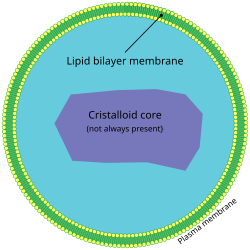Peroxisomal disorders
Peroxisomes[edit | edit source]
Definition and characteristics[edit | edit source]
Peroxisomes are membranous organelles (membrane bilayer) found in the cytosol of all cells, numbering about 1000 per cell. They have many functions some of which are as follows:
- Antioxidation: Peroxisomes, using primarily the enzyme catalase, they neutralize reactive oxygen species (ROS), such as hydrogen peroxide H2O2 maintaining a vital equilibrium between antioxidants and ROS preventing oxidative stress.
- Oxidation of very long chain fatty acids (VLCFA): VLCFAs cannot enter mitochondira in order to be oxidized into acetyl-CoA. They can be oxidized, however, in peroxisomes through β-oxidation (the same mechanism used in mitochondria for fatty acid oxidation) yielding acetyl-CoA and long chain fatty acids (LCFA) which can subsequently enter mitochondria and further being oxidized.
- Synthesis of plasmalogen: plasmalogen is an ether phospholipid (complex lipid) required for the normal function of the cell membrane.
- Synthesis of bile acids: bile acids are secreted in bile and they are necessary for emulsification of dietary lipids in intestines (emulsification is the breakdown of a large lipid droplet into smaller ones). Bile acids, through emulsification, increase the surface on which the pancreatic lipases can act and thence enhance the lipid breakdown and absorption.
Biogenesis[edit | edit source]
Peroxisomes, as lysosomes, function properly only when all peroxisomal proteins and enzymes are accommodated within the peroxisomal compartment. Since these enzymes are synthesized in the cytosol, there must exist a transport mechanism which will uptake them and transport them across the cytosol and inside the peroxisomal compartment. If there is an impairement in this mechanism, the peroxisomal enzymes will accumulate in the cytosol instead, giving rise to the so called 'peroxisomal ghosts' leaving behind an incompetent peroxisome, resulting in accumulation of unmetabolized substrates and deficiency of products. The transport mechanism is as follows:
- The newly synthesized peroxisomal proteins contain in their sequence the so called Peroxisomal Targeting Signal (PTS), an amino acid sequence recognized by cytosolic receptors called PEX receptors encoded by the peroxin genes. These receptors will lead to the proper compartmentalization of the proteins inside the peroxisomes.
- The PTS1 is the group of matricidal peroxisomal proteins that contain their PTS on the C-terminal of their polypeptide sequence. The PTS1 proteins are recognized and bound to by the PEX5 receptors encoded by the PEX5 peroxin gene.
- The PTS2 is the group of matricidal peroxisomal proteins that contain their PTS on the N-terminal of their polypeptide sequence. The PTS2 proteins are recognized and bound to by the PEX7 receptors encoded by the PEX7 peroxin gene.
- The mPTS is the group of membrane peroxisomal proteins believed to be recognized and bound to by the PEX19 receptor encoded by the PEX19 peroxin gene.
Peroxisomal Disorders[edit | edit source]
The peroxisomal disorders are divided in two groups according to the defect present both leading, however, to accumulation of substrates and deficiency of products:
- Due to defects in the biogenesis and assembly of the peroxisomes. These defects develop on the proteins of the transport mechanism resulting in 'peroxisomal ghosts' with accumulation of normal peroxisomal enzymes outside the peroxisomal compartment.
- Due to defects on the peroxisomal enzymes. Although these enzymes are properly compartmentalized within the peroxisome, they are functionally incompetent.
Disorders of the peroxisomal biogenesis[edit | edit source]
- Zellweger syndrome: characterized by impairement of many PEX receptors due to mutations on the peroxin genes. (PEX1, PEX2, PEX3, PEX5, PEX6, PEX10, PEX12, PEX13, PEX14, PEX16, PEX19, and PEX26 genes) all involved in the assembly of peroxisomes. In this syndrome there is accumulation of VLCFA due to insufficient βι
- Neonatal Adrenoleukodystrophy (N-ALD):
- Infantile Refsum disease:
Disorders of the peroxisomal enzymes[edit | edit source]
- X-linked Adrenoleukodystrophy (X-ALD)
- Refsum disease


